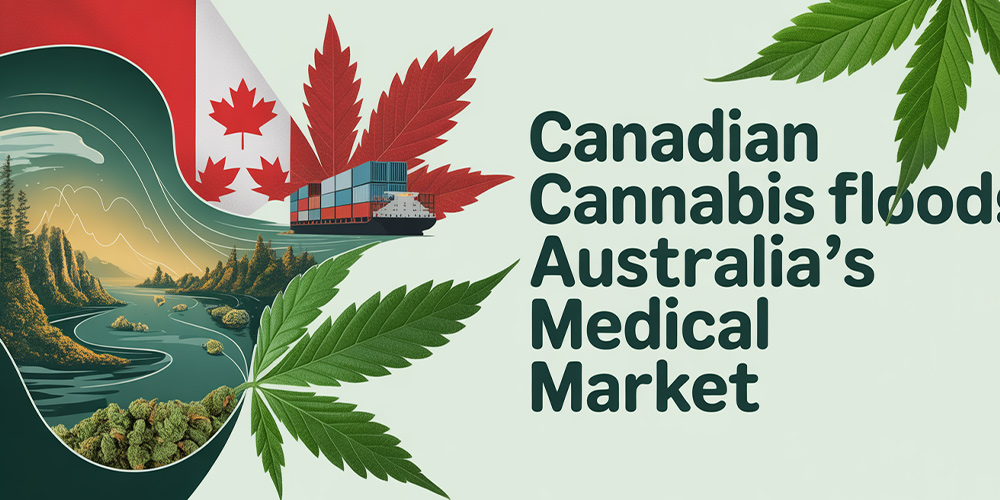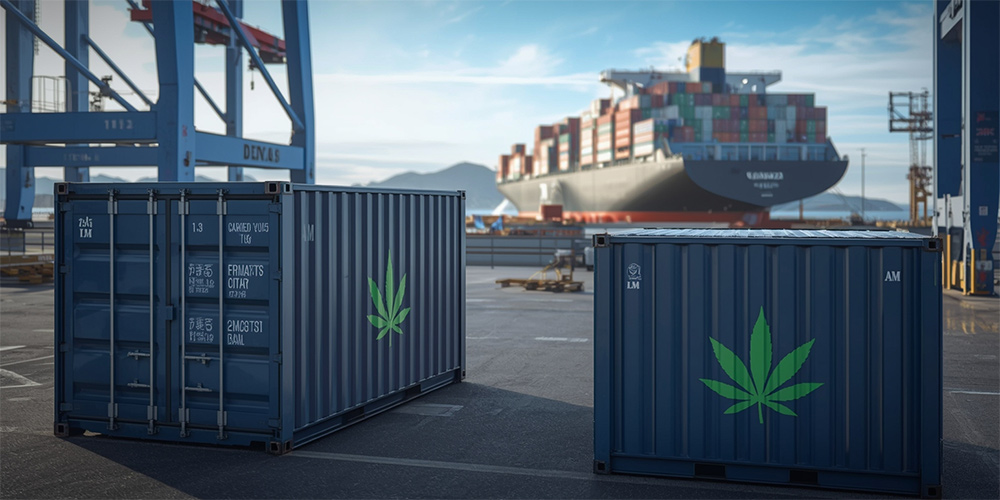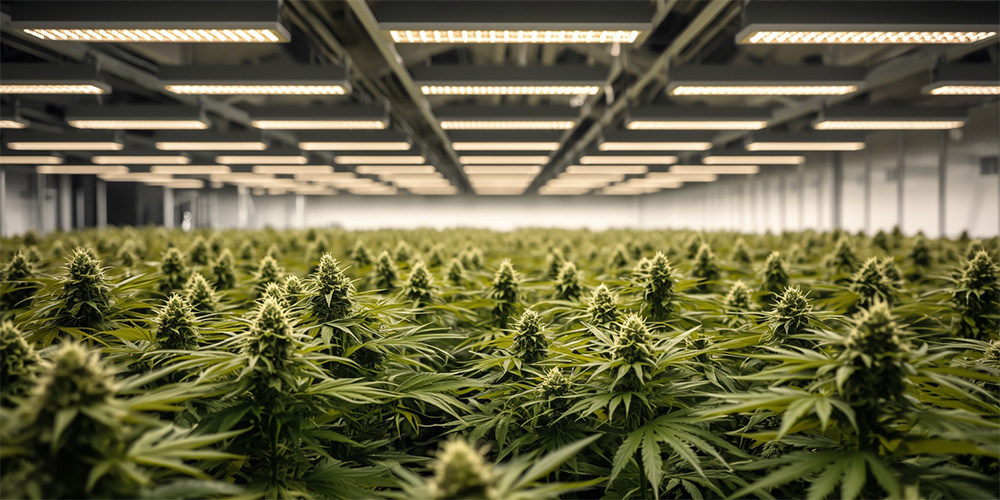
Home » Canadian Cannabis Floods Australia’s Medical Market as Local Producers Struggle to Compete
Canadian Cannabis Floods Australia’s Medical Market as Local Producers Struggle to Compete
Australia’s medicinal cannabis market is booming — but much of the product fueling that growth is coming from overseas. In 2024 and 2025, imports from Canada surged nearly 75%, accounting for more than 80% of all cannabis entering Australia’s regulated supply chain. The rapid influx of foreign product is igniting debate among local growers, regulators, and healthcare professionals over quality control, domestic industry viability, and long-term sustainability.

Canada’s Green Wave Hits Australian Shores
Canada’s dominance in Australia’s medicinal cannabis supply has been building since legalization there in 2018. But the most recent data from StratCann and Australian customs reports indicate that Canadian exports to Australia have reached record highs, with over 2,000 kilograms of medicinal cannabis products entering the country in 2024 alone — up from just over 1,100 kg in 2023.
The surge reflects both strong patient demand and limited domestic production capacity. While Australia has issued more than 1.4 million medicinal cannabis prescriptions since legalization in 2016, only a fraction of the medicine consumed is grown locally. Domestic producers face high regulatory costs, complex licensing processes, and inconsistent market access across states and territories.
In contrast, Canada’s mature industry offers economies of scale, low-cost cultivation, and established export channels, making it easier for Canadian companies to ship product directly to Australian distributors and pharmacies.
“The economics simply favor imports,” said one Sydney-based distributor who asked not to be named. “Australia’s framework was designed for safety and control, not efficiency. Canadian producers can supply the same GMP-certified product at half the cost.”
Domestic Producers Feel the Squeeze
For Australian cultivators, the influx of Canadian product is both a commercial and existential challenge. Companies that invested millions into domestic greenhouses and pharmaceutical-grade facilities now face declining wholesale prices and dwindling market share.
According to industry analysts, wholesale flower prices have dropped by nearly 30% in the last 18 months. Many local producers are scaling back expansion plans, and some have already pivoted to export markets or diversified into hemp-derived wellness products.
“It’s becoming increasingly difficult for Australian producers to compete on price, even with our own backyard advantage,” said James Rushton, CEO of Melbourne-based grower Southern Botanics. “If regulators don’t balance import and local supply, we risk hollowing out an emerging domestic industry before it truly matures.”
The issue is further complicated by supply chain bottlenecks and inconsistent prescribing patterns. While some pharmacies stock a wide range of Canadian products, others face periodic shortages due to customs delays or labeling discrepancies. Patients, meanwhile, are often unaware of the product’s origin — a concern for those seeking traceability or specific strain consistency.

Quality and Compliance Concerns
Despite Canada’s robust regulatory framework, critics warn that reliance on imports could undermine Australia’s product oversight and safety transparency. Medicinal cannabis products imported under the Therapeutic Goods Administration (TGA)’s unapproved medicine pathways — such as the Special Access Scheme (SAS) or Authorised Prescriber program — are not subjected to the same level of testing or approval as other prescription drugs.
The Australian Medical Association (AMA) and Therapeutic Goods Administration (TGA) have both raised red flags about a potential “wild west” dynamic emerging in the sector. In recent months, the TGA has issued multiple infringement notices totaling more than AUD $100,000 against companies for illegal advertising and misleading claims related to medicinal cannabis.
“When most of your market relies on unapproved imported products, there’s an inherent risk in quality control,” explained Dr. Rachel Meyer, a pharmacologist specializing in plant-based medicines. “Australia needs more robust post-market surveillance, not less.”
Canada–Australia Cannabis Trade: A Two-Way Relationship?
While Canadian exports dominate, some experts argue this trend could help accelerate Australia’s domestic expertise. Partnerships between Canadian and Australian firms have led to technology transfers in cultivation, GMP manufacturing, and clinical research.
For example, Toronto-based Tilray and Aurora Cannabis have both established operational footprints in Australia, collaborating with local partners to cultivate, process, and distribute medicinal products domestically. This hybrid model could evolve into a balanced trade ecosystem, where local production scales up alongside imports.
However, industry analysts warn that without strategic import caps or preferential procurement policies, local players could be permanently sidelined.
“It’s similar to what happened with wine and dairy decades ago,” noted Dr. Alan Whittaker, senior fellow at the Australian Institute for Health and Policy. “Without coordinated trade policy, foreign supply will dominate until it’s too late for domestic firms to recover.”

Patients Caught in the Crossfire
For patients, the short-term impact is mostly positive: greater product availability, lower prices, and more variety in THC and CBD formulations. Yet some worry about product consistency and long-term reliability. Imported batches can vary in terpene profiles, cannabinoid potency, and even labeling standards.
The lack of standardized national formularies also means different doctors prescribe vastly different brands and dosages, sometimes without full knowledge of comparative potency or interactions. A recent AHPRA update warned that “most medicinal cannabis products used in Australia are unapproved medicines, meaning they have not been assessed for quality, safety, or efficacy.”
Consumer advocacy groups are now calling for a centralized registry of imported cannabis products, similar to the ARTG (Australian Register of Therapeutic Goods), to improve transparency and data collection.
Looking Ahead: Regulation or Dependence?
The question for policymakers is whether Australia wants to remain a dependent import market or invest in a self-sufficient cannabis ecosystem. While short-term access is critical for patients, long-term sustainability will require support for domestic cultivation, GMP certification programs, and research funding.
The Department of Health is reportedly reviewing its medicinal cannabis framework, with consultations expected in early 2026. One proposal under discussion is a tiered approval system, rewarding companies that invest in local production with faster market access and public funding support.
“The market is at a crossroads,” said Dr. Whittaker. “Either Australia becomes a hub of innovation and quality manufacturing — or it remains a customer in a global cannabis supermarket.”

